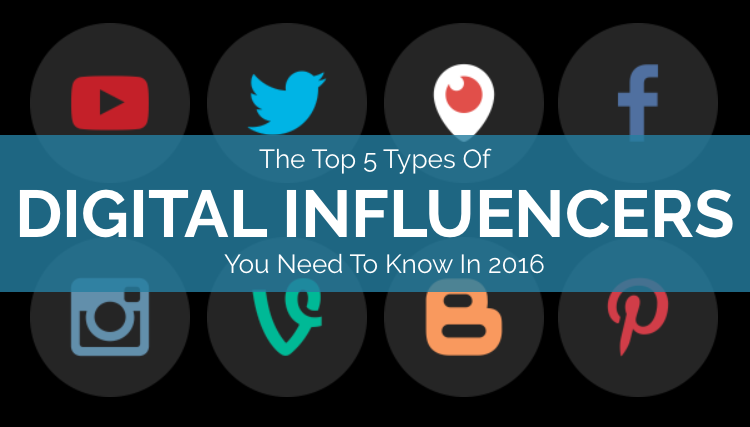The 5 Types of Digital Influencers You need to Know
In a recent WSJ article, Donna Lagani SVP and CRO of Cosmopolitan (part of Hearst) relates how every CMO is concerned with influencer marketing and creating content alongside social and digital influencers. With rising rates of ad blocking, rising rates of social media app use, and declining rates of TV viewership, brands, and marketers of all industries are realizing just how critical digital influencers are to an effective, comprehensive, and multi-platform marketing strategy.
To learn more about digital influencers, who they are, and which types brands need to know, check out our explainer post here:
What is a Digital Influencer?
A digital influencer is someone who has amassed noteworthy followings across social media networks, channels, and platforms. Many digital influencers begin building their social following from a singular expertise or content/interest niche (e.g. tech, fashion, food, beauty, adventure) and later, expand on to other categories.
The 5 Types of Digital Influencers Brands Need to Know
The YouTuber – some of the world’s biggest digital influencers are found on YouTube. With an active audience of over 1 billion and hundreds of millions of hours watched, top YouTubers or YouTube influencers are in demand for their ability to connect with vast audiences. Because of their digital success and reach, Top YouTubers like Lilly Singh “Superwoman” are sponsored by some of the world’s most recognizable brands and becoming a force in mainstream entertainment.
The Instagrammer – Instagram is the number one social media platform for brand engagement (Forrester). As such, many brands are seeking to leverage the reach and engagement of top Instagram influencers or Instagrammers to drive brand campaign marketing initiatives.
The Snapchatter – Snapchat is quickly becoming one of the hottest platforms for marketing and advertising, as evinced by our post, “10 Top Snapchat Statistics Marketers Must Know For 2016.” While there is development on a Snapchat API, presently marketers seeking to engage Snapchat’s highly engaged audiences partner with top Snapchatters.
The Vine Star – while Vine may not enjoy as much media attention as Snapchat, Instagram, and YouTube, top Vine stars are a huge hit with brands and across multiple social media channels. See how brands like Mastercard and Hyundai are collaborating with top Viners or Vine stars.
The Blogger – as the original digital influencer, many top bloggers first amassed their audiences from blog viewership. Many have continued their online reach and prominence onto newer platforms. Advertising with bloggers remains one of the best and preferred ways to market to audiences online by some of the world’s top brands.
With the continual evolution and emergence of new social platforms (e.g. Periscope, Facebook video, YouNow), new digital influencers will always continue to surface, however, many of today’s successful social media influencers will oftentimes bring much of their existing audiences with them to new platforms.
Why are Digital Influencers Important for Today’s Brands
At the end of 2015, Bloomberg announced that Americans now spend more time on social media apps than TV (well over 3 hours). Coupled with the rise of ad block technology on both desktop and mobile (Apple’s operating system iOS9 includes built-in ad block tech), brands and advertisers are left with few viable marketing channels.
While native advertising options do exist (see our article “Native Advertising vs. Sponsored Content vs. Influencer Marketing”), collaborating and creating marketing content with top digital influencers is one of the most effective advertising channels available today. By working with top digital influencers, brands are able to target vast amounts of engaged online audiences and create unique content that is seen, shared, liked, and followed by millions.
How to Find and Work with Digital Influencers.
While there are many ways to find top digital influencers or social media stars (including top lists like Socialblade and platforms), truly crafting and maximizing a winning brand strategy that succinctly integrates messaging, branding, and an effective CTA (call-to-action) alongside high-converting, proven influencers requires longstanding insight and experience executing similar campaigns.
With the evolution of influencer marketing, social channels, and audience engagement, many brands are realizing how longer term collaboration and a comprehensive, multi-platform brand strategy integrating top digital influencers elicit greater ROIs and engagement vs. a one-off sponsorship. In Adweek’s article, “Brands’ Next Big Celebrity Deals May Be With Social Media Stars,” Dick’s Sporting Goods director of digital relates how many brands are now creating year-long strategies using key influencers across multiple campaigns. “It’s not just one and done—it is a relationship that we’ve developed with social media influencers,” explained Jay Basnight, director of digital at Dick’s.
Article Written By: MediaKix
0

